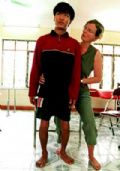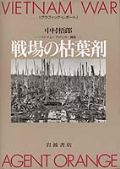|
|

Duong Thi May (13 years old) from Ha Tay
Province having fun with her
classmate.nbsp;

In a classroom tonbsp;
improve
eye-sight.nbsp;

Vu Xuan Nhien (17 years old) and his
friends in the functional rehabilitation
room.nbsp;

Suel Jones talking with Vietnamese
veterans whonbsp;are treated at the
Village.

Danish volunteer Ellen Laugesen helping
Nguyen Tien Mao with his
rehabilitation.
| A
village filled with love, affection and humanness that embraces
entirely all the sufferings of the kids, the war veterans and the
former youth volunteers. All of them are victims of the Agent
Orange/ dioxin, a chemical toxicant that was sprayed by the American
GIs over Vietnam during the war. It is the Vietnam Friendship
Village.
The kids' sufferings and the kind
heartsnbsp;
nbsp;Little Duong Thi
May always wished to wear a doctor's gown. She applied the
stethoscope on a teddy bear and laughed. A few kids around heartily
laughed with her, their heads keeping turning back and forth,
seemingly boneless, their hands waving in the air, with no definite
direction, in a charitable class of the Vietnam Friendship Village
for mentally-retarded kids due to the effects of the US dioxin. May
is 13, but she knows nothing, is unable to talk fluently, nor walk
with ease due to for her bandy legs. Her father is dead and she has
four elder brothers, all mentally retarded.
The educational course is
a special one. The students are all disabled, retarded and of
different ages. Teaching them is a hard job. They are of the 3rd
grade but many of them find it hard to do the reading. Only a few of
them can. Their pronunciation is distorted due to their twisted lips
and their memory is quite short. They easily forget what they've
learned. "We make every effort to help them; the more they can
learn, the better," said Nguyen Thi Yen, their teacher. Besides
general education, they are also trained in such handicrafts as
embroidery, tailoring, plastic-flower making ...nbsp; Even though
their fingers remain awkward and clumsy, and their understanding
weak and deficient, their products can meet all expectation, to some
extent. This has given them a source of joy, some self-confidence
and a dream of doing something helpful for their families when
returning to the normal life among their community.
In the Village, it is
quite hard to tell the kids' exact ages. Some in their twenties have
a physical statures as small as the 7- or 8-years-old. They find it
difficult to feed themselves, much less have mental ability or
physical capacity for work. No one can hold back the tears when
seeing the heads turning round unconsciously, the bandy arms
managing to push the spoon of food into the mouths with awful
difficulty ... Yet they still keep smiling, singing in their great
innocence, at the presence of some visitors, craving for something
beautiful.
Ellen Laugesen, a Dane
and one of the volunteers who has been working for the Village as
expert in physio-therapy has donated a whole set of equipment to its
functional-rehabilitation section. For years she has been coming to
the Village to help train its two technicians in direct treatment of
the kids. Many of them with deformed arms and legs, moving around on
their toes trembling all along can now walk better, after some time
of great care by the technicians. Nonetheless quite of few of them,
though staying in the Village for a long time, are not allowed to
return to their families due to their worse conditions. For these
cases, they need major surgery, but the Village's utterly limited
budget cannot cover all, as it depends mainly on the assistance from
the NGOs and charity people, both at home and abroad, and its own
meager efforts.
One of the
friends
Suel Jones, one of the
American Vets, who joined in the US War in Vietnam in 1968, is now a
member of the International Committee for Friendship Villages. He
has been staying in Vietnam for four years, becoming one of the
Village's volunteers and making recommendations for international
delegations to visit the Village, hence their possible and potential
financial assistance. Today Suel Jones is returning to the Village
visiting the kids and meeting with the war veterans and the former
youth volunteers who are under treatment there.nbsp;
Sitting in the small room
of the veterans just back from their physio-therapy, Suel Jones was
talking to them over a cup of green tea. The story about Vuong, a
vet from Thai Nguyen Province, touched him to the heart. After his
demobilization, Vuong returned to his home village and had seven
children, three of whom died from the dioxin effects on the father
and one could not open the eyes until three months after birth. The
American vet was awfully saddened because all the Vietnamese vets in
the Village were in awkward circumstances. Even Suel Jones himself
was a victim of the Agent Orange/dioxin. After his return from the
Vietnam War, his wife would never be a mother, after her several
miscarriages. He wished to share responsibility, to some extent, as
a magnanimous gesture of humanism to the Village by joining in the
care and treatment of the war veterans, the victims of the Agent
Orange/dioxin and the crippled by the war now living in untold
difficulties.nbsp;
On late that afternoon
Suel Jones was on his way home, reluctant to part with the kids
playing on the grounds of the Village, among their deep attachment.
A little boy was grabbing at his pants, smiling and saying something
unintelligible, his head falling to one side. He was bidding
good-bye to the American friend, I guessed.
|
The Vietnam
Friendship Village, under Vietnam Veterans' Association, in
Van Canh Commune, Hoai Duc District, Ha Tay Province, was set
up on March 18, 1998, with assistance and support from the
Vietnamese Government and the veterans from Germany, France,
the United States, Japan and the UK. It is aimed at providing
care and medical treatment, teaching and job-skill training
for crippled kids, veterans and former youth volunteers, all
of them victims of the Agent
Orange/dioxin.nbsp; |
nbsp;
nbsp;
nbsp;
nbsp;
Story:nbsp; Vuong
Mo
nbsp;nbsp; |







